- Makauwahi Cave
-
The Makauwahi Cave is the largest limestone cave found in Hawaii. It lies on the south coast of the island of Kauaʻi, in the Māhāʻulepū Valley close to Māhāʻulepū Beach, and is important for its paleoecological and archaeological values. It is reached via a sinkhole and has been described as “…maybe the richest fossil site in the Hawaiian Islands, perhaps in the entire Pacific Island region”.[1]
Contents
History
Though known historically by the inhabitants of the island, and used as a grave site by ancient Hawaiians, the cave’s paleontological value was first realised in 1992 by David Burney, Lida Pigott Burney, Helen F. James and Storrs L. Olson, who found the cave’s access sinkhole while searching for fossil sites on the south coast of Kauaʻi. The traditional name of the cave, Makauwahi, or “smoke eye” in Hawaiian, was rediscovered in 2000 by a local archaeologist, William Pila Kikuchi, who found the name in a high school student’s essay written over a century previously.[1]
In 2004 the Burneys acquired a lease on the cave property, now the 17 ha (42 acre) Makauwahi Cave Reserve, which is subject to environmental restoration after having been used for sugarcane and maize farming before being abandoned to weeds. The area is being planted with threatened native plants, such as the local Pritchardia palm.[1][2]
Description
The site is apparently geologically unique in the Hawaiian Islands, comprising a sinkhole paleolake within a large cave system formed in eolianite limestone. The paleolake contains nearly 10,000 years of sedimentary record; since the discovery of Makauwahi as a fossil site, excavations have found pollen, seeds, diatoms, invertebrate shells and Polynesian artifacts, as well as thousands of bird and fish bones.[1][3]
The findings document not only the conditions before human colonisation of the Hawaiian islands, but also the millennium of human occupation with the drastic ecological changes that occurred since first Polynesians, and later Europeans and Asians, arrived in the islands along with a suite of invasive alien species. They reveal the existence of a large number of native birds that became extinct as a result.[1] The cave has also shown that certain plants previously believed to be Polynesian introductions, such as Kou (Cordia subcordata) and Hala (Pandanus tectorius), existed on the islands prior to human settlement.[4]
Remains of some 40 species of birds have been found in the cave; half of these species are now extinct. New discoveries of extinct species include the Turtle-jawed Moa-nalo (Chelychelychen quassus), the blind and flightless duck Talpanas lippa, and the Kauaʻi Palila (Loxioides kikuichi).[1]
See also
References
Notes
Sources
- "Hawaiian Cave Reveals Ancient Secrets". David A. Burney and Lida Pigott Burney. Live Science. 25 October 2008. http://www.livescience.com/history/081025-hawaii-cave.html. Retrieved 3 March 2010.
- Kido, Michael H. (2008). "Hawaii EPSCoR Cyberinfrastructure to Enhance Paleoecological Research at the Makauwahi Cave Reserve Site on Kauai". EPSCoR Newsletter 11 (Spring): 3. http://www.epscor.hawaii.edu/nl/spring08vol11.pdf.
- Levy, Sharon (2008). "Lessons from a Limestone Cave — Looking to the past to restore the future of a Hawaiian Island". Wildlife Conservation (January/February): 46–51. http://ntbg.org/cms_files/LessonsOfALimestoneCave_WildlifeMagazine_JanFeb08.pdf.
External links
Categories:- Caves of Hawaii
- Archaeological sites in Hawaii
- Limestone caves
- Paleontological sites of Oceania
- Landforms of Kauai
- Sinkholes of the United States
Wikimedia Foundation. 2010.

